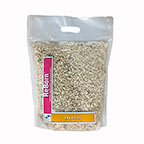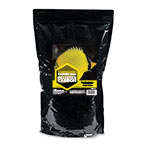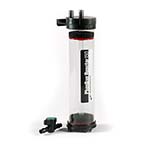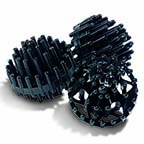Overview
| * | Aquarium nitrate and phosphate removing biopolymer filter media |
| * | Naturally reduce aquarium phosphate levels with beneficial bacteria |
| * | Bacteria uses up nitrate and phosphate as it grows on the filter media |
| * | Use bioplastic media in fluidized reactor such as the PhosBan Reactor 150 |
Harness the power of nature to reduce aquarium nitrate and phosphate levels. Two Little Fishies NPX Bioplastics is a biopolymer filter media that helps maintain aquarium water quality by supporting the growth of nitrate and phosphate reducing bacteria. Enjoy natural and cost-effective management of aquarium phosphate levels by cultivating beneficial bacteria!
NPX Bioplastics are pelletized biodegradable polymers you use in a fluidized reactor. As bacteria populate the pellet surfaces, excess growth sloughs off to be harvested by a protein skimmer or become a natural food source for filter-feeding invertebrates such as corals, clams and sponges. Anaerobic zones within the pellets promote conditions where bacteria associated with denitrification (nitrate removal) thrive. Use this natural approach in conjunction with protein skimmers and phosphate-removing media to combat high levels of nitrate and phosphate that pollute aquarium water quality.
Install NPX Bioplastics in the PhosBan Reactor 150 using the NPX BioPlastics Screen for convenient nitrate and phosphate control (each sold separately). Allow time for bacterial population to reach effective levels. For best results, begin with smaller quantities and add more NPX Bioplastics as media becomes inoculated with beneficial bacteria. After two to four weeks, nitrate and phosphate levels will decrease. 200ml treats aquariums up to 50 gallons.
Use NPX Bioplastics in conjunction with proper aquarium filtration and employ strong water circulation and aeration. The use of NPX Bioplastics in marine aquariums must be accompanied by the use of a protein skimmer to achieve the export of bacteria and assimilated nutrients.
Directions for Use
NPX Bioplastics are best installed in a fluidized filter like the PhosBan Reactor 150 (#18413) or 550 (#71947). Warning: To avoid the potential for a cloudy white bacteria bloom in the water DO NOT use a full dosage to start on aquariums with high nitrate concentration. Start at 1/2 the recommended dosage and gradually increase after a few weeks to 100 ml per 25 gallons.
If a bloom develops, remove 1/2 of the NPX Bioplastics from the reactor and store it damp but not submerged in a bag. For aquaria with heavy feeding, higher quantities can be used but the accumulation of phosphate from the food may require the combined use of NPX Bioplastics and PhosBan granular ferric oxide media (#13157) in separate reactors. Observe the level of media within the filter and top off as necessary about every three to six months because NPX Bioplastics are slowly consumed.
Caution
Maintain sufficient water flow through NPX Bioplastics to prevent production of hydrogen sulfide gas. Employ strong water circulation, aeration and/or a surface skimming overflow in the aquarium to maintain high levels of oxygen saturation when using this product because of the strong influence it has on oxygen saturation. The use of NPX Bioplastics in marine aquariums must be accompanied by the use of a protein skimmer to achieve the export of bacteria and assimilated nutrients. It is not necessary for the outlet of the filter containing pellets to be positioned near the intake of the protein skimmer, but it is necessary to have a protein skimmer running on the system.
General information
NPX Bioplastics are pelletized biodegradable polymers that promote the development of bacteria that assimilate nitrate and phosphate. As bacteria develop on the pellet surfaces, excess growth sloughs off due to the tumbling in a fluidized filter and these bacteria can be removed with a protein skimmer or serve as planktonic food for filter-feeding invertebrates such as corals, clams and sponges. Anaerobic zones also develop within the pellets, thus promoting denitrification there.
NPX Bioplastics granular plastic media is made from biodegradable polymers. It is for use in a fluidized reactor. The slow release of organic food from these plastics promotes the development of bacteria that assimilate nitrate and phosphate. These bacteria can be harvested by protein skimmers, so that the nitrate and phosphate levels are naturally reduced. The bacteria are also a food source for filter-feeding invertebrates such as corals, clams, sponges, and feather dusters.
NPX Bioplastics Screen
Instruction for the NPX Screen for the PhosBan Reactor 150 and PhosBan Reactor 550
Description
The NPX Screen prevents NPX Bioplastics or other biodegradable pelletized media from passing through the dispersion plates in the PhosBan Reactor 150 or PhosBan Reactor 550.
NPX Screens are to be used instead of the Foam Sponges in the PhosBan Reactors. Remove the sponges and position the cut screens on top of the Dispersion Plates. Normally the Screens will fit snugly in place if they are cut correctly, but small plastic zip ties can also be used to secure them to the Dispersion Plate.
- Preparing the Screens for the PhosBan Reactor 550
- Using scissors cut the Screen diameter down by two windows, leaving the outer Rib intact. Using a fine-pointed scissors or a utility knife, carefully cut out the first two windows inside the center of the Screen so that it fits snugly over the Center Pipe of the PhosBan Reactor.
- Preparing the Screens for the PhosBan Reactor 150
- Using scissors cut the Screen diameter down by five windows, leaving the outer Rib intact. Using a fine-pointed scissors or a utility knife, carefully cut out the first two windows inside the center of the Screen so that it fits snugly over the Center Pipe of the PhosBan Reactor.
- Finishing the Assembly
- Slide the Screens onto the clear pipes and over the Dispersion Plates, Insert the Lower Assembly into the PhosBan Reactor and press the Screen down (by hand for the PhosBan Reactor 550 and using a yardstick for the PhosBan Reactor 150) to be sure the inserted screen is sitting flat all the way around the Dispersion Plate. Plastic zip ties can be used to secure the Screen but are usually not needed. Add NPX Bioplastics and then insert the Upper Dispersion Plate and Screen the same way.
Guidelines
NPX Bioplastics are best employed in a fluidized reactor such as the PhosBan Reactor 150 or 550.
When using NPX Bioplastics in a PhosBan Reactor, the sponges from the reactor must be removed and replaced with NPX screens, available in a pack of 2 (#75541).
For 200 ml of NPX Bioplastics use the PhosBan reactor 150 (#18413) and choose a pump with 300 - 350 gph capacity.
For 400 ml of NPX Bioplastics use the PhosBan reactor 550 (#71947) and choose a pump with 350 - 500 gph capacity.












